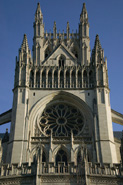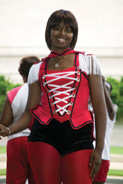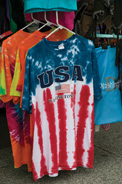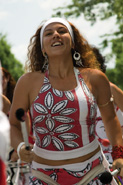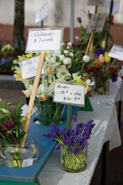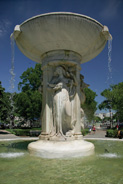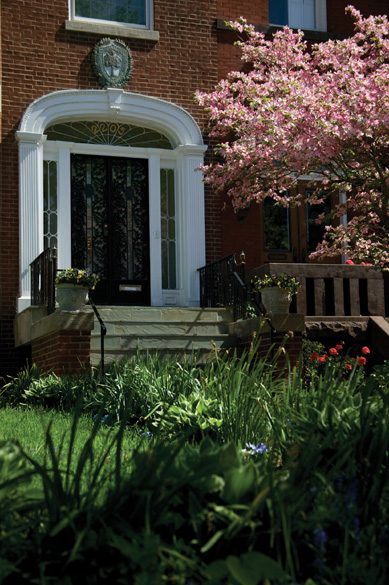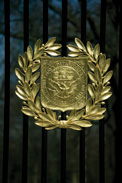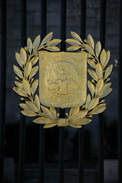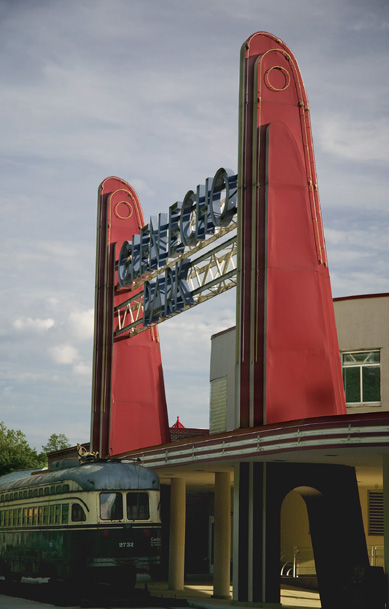
The main entrance to Glen Echo Park.
Amid the hustle of politicos, the formulated streets, and the legions of populace, you can find unknown areas in DC that are tucked away, visited by few—both city dwellers and tourists alike. These places are photographic treasures—they boast visual opportunities that will, without a doubt, add fresh images to your repertoire that will be of great interest to bring home. In this chapter, we will discover newly developing areas in Washington, DC, pay a call to a landmarked commercial venture, take in a country resort from days gone by, and discover a bit of international culture. Set your lens on the sights at a few of these locales, and you will be impressing even some jaded Washingtonians with your geography know-how.
The three most important elements to focus on in your travel photography are composition, narrative, and a passion for your subject. The first two aspects usually reside in the subconscious of a professional, but with time and practice you will find that your sense of artistry and your ability to be a visual storyteller will also become second nature. The third component, on the other hand, is an area where you actually have the better hand over the professional who makes his or her living taking pictures. A professional must travel to and shoot where his assignments and editors send him, but you, on the other hand, are completely free to choose whatever and wherever you would like to make images.
If artistic coaches could bottle anything and sell it to their students, it would be the ability to convey ardor and feeling into one’s photographs. It is really an indescribable concept, and when looked at coldly and factually, this conveyance is almost physically impossible. But, it is there nonetheless, and it is what separates adequate photography from images that are memorable.
If you cannot see your subject, you can be assured that you will not devote too much time to your compositions. For this reason (and others on which I will elaborate in the next paragraph), I advocate that if you are serious about improving your photographic and artistic skills, you invest in a digital SLR as your working camera, as opposed to a point-and-shoot. With a point-and-shoot camera, your actual “canvas” is visible only on the (probably) small LCD screen on the back of the apparatus. dSLRs, on the other hand, have viewfinders that are large, accurate, and bright. It is here, in the viewfinder, where you will be composing your images, and it is crucial that you be able to see as many of the elements in front of you as possible. Of course, there is the optional but cumbersome method that many professionals use, which is to shoot tethered. Tethered means that your camera is connected to a computer (laptop or desktop) via a FireWire, and the images are downloaded within seconds into a capture program and are then visible on the computer monitor. Viewing your captured image on a monitor obviously makes composition a relative breeze, but there are disadvantages, of course. In addition to the cost involved for the equipment, this shooting method requires that the photographer be quite stationary and/or have assistance with carrying the gear and fending off would-be thieves!
There are several other great advantages to shooting with a dSLR that I would like to mention. First, with a dSLR, you have the ability to turn off the auto focus and manipulate it yourself. With the bright viewfinder, you can see exactly where you are focused, and for artistic reasons, your focus point decision may be different from where the camera’s automatic system decides to focus. You may prefer to have only a small object in the foreground sharp and leave the background soft. Using the manual focus makes this extremely easy and quick to do.
Second, you will find that most point-and-shoot cameras have a decided lag between when you press the shutter release button and when the camera actually fires. This lag can range anywhere from 0.6 seconds to an interminable 2.5 seconds, depending on the lighting situation in which you are shooting. (The auto-focus system in a point-and-shoot takes much longer to kick in under a low-light situation.) This shutter lag can be a serious detriment, particularly when you’re shooting action, children, animals, or anything with movement. Even portraits can be disheartening when the shutter lag comes into play, since your subject may smile on cue for the camera, but then her expression might quickly turn when the shutter does not release!
And third (but definitely not last), the point-and-shoot is usually not adaptable to a quality external electronic flash. This can cause a lot of creative issues if you have taken a liking, as I have, to carrying an on-camera flash in your kit. If controllable creativity with light, composition, and focus is in your plan, then a dSLR should be your tool of choice. There are many pro-sumer models on the market today that are affordable and will more than suit your needs.
The photo opportunities in this chapter are essentially “still life” in nature and will give you countless circumstances to hone your composition and narrative skills. The most important aspect when learning to compose is to really look and see what your camera is recording. If your apparatus has a nice and bright viewfinder, be sure to take the time to look at all four edges of the frame. If you use the LCD screen, do the same. Don’t just point and shoot. Look for objects that may be distracting—traffic cones, extension cords, lampposts, car bumpers, and so on. If there is something entering into your frame that you deem unappealing, change your position and shoot the subject from a different angle. I find that crouching down and shooting from a lower angle than normal tends to clear up the background of some distracting elements and very often frames the subject against the sky. Experiment with wide and narrow apertures to change the focus of your backgrounds. With still objects, taking multiple frames is easy and great practice.
Learn to apply knowledge that you have gained from other parts of your life to your photography. If you have taken a creative writing course in the past, remember the literary metaphors that you learned and apply them to your picture taking. Did you study poetry in college? How about all the symbols and icons that apply there? They have just as much impact when used in photography. That apple you see on the table can represent temptation, and the black crow in the tree is imminent death or danger. A shadowed doorway can be an icon for the unknown future. Flowers can represent mortality, and those swans gliding on the lake are icons for alteration and change. Open your mind to all the arts, and your pictures will reflect the creativity and passion that you feel.
Whatever your feelings on the current state of healthcare in the United States, you may care to visit the Stabler-Leadbeater Apothecary Museum to gain insight into a medical provider from earlier times. Since the 1790s, an apothecary has stood on Fairfax Street in Old Alexandria. Initially owned and run by the Stabler family and then in turn by members of the Leadbeater family (related through marriage), the Apothecary supplied salves, herbs, and tinctures to the people of Alexandria and Washington, DC until eventually succumbing to the Great Depression in 1933. At that point, rather than simply disappearing into the annals of lost businesses, the apothecary was jointly purchased and preserved by the Friends of the American Pharmaceutical Association and the Landmarks Society of Alexandria. In 1939, the building reopened as a museum and has entertained visitors ever since. The collection of exhibits includes shop furnishings, gold-leaf labeled bottles and formulating equipment, original medicinal herbs, and records of business transactions, many still in their historical settings. The displays provide a visually appealing window into the medicine of times past.

A view from the street to the interior.
The Apothecary Museum is beautiful and interesting, but all interior and dimly lit. Your tripod is mandatory here for every shot taken inside the space. The small windows are north facing, and the light is reminiscent of that seen in Vermeer’s and other Dutch painters’ still-life works, while the composition mirrors the American trompe l’oeil painters, such as William Harnett and John Peto. It is times such as these when your college art history classes come in handy!
I had neglected to put my cable release in my gear bag, but with my tripod and a bit of ingenuity, I was able to capture sharp images. I put the shutter speed on 10 seconds and pressed the shutter release button while holding a dark-brown postcard from the museum directly in front of the lens, but not touching the camera. I knew that the shutter speed for a correct exposure was 2 seconds from a previous capture, so while the shutter was open, I whisked the card away for 2 seconds, replaced it, and then closed the shutter. Voilà—a sharp, long-exposure image without a cable release!
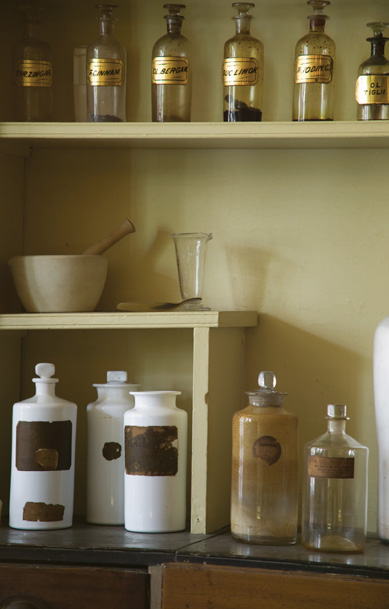
Focal length 135mm; ISO 100; aperture f/5.6; shutter speed 2 seconds; April 1:02 p.m.
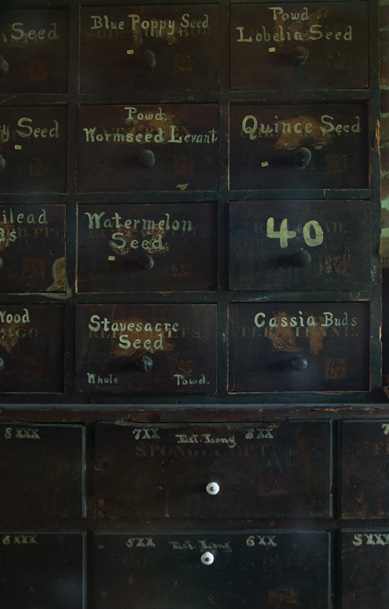
Focal length 35mm; ISO 100; aperture f/5; shutter speed 5 seconds; April 1:22 p.m.
The second floor of the Apothecary Museum is just as interesting as the first, but, unfortunately, it is even darker! Two large bureaus flank the room, and each unit is hand-labeled with powdered and flaked homeopathic remedies that are actually still inside the drawers. The contents range from cuttlefish bone to watermelon seed to laundry bluing—quite an odd collection, to be sure. The lighting here is a combination of tungsten illumination from a small overhead electric fixture and a smattering of available window light. I followed pretty much the same technique as in the making of the photograph from the main room on the first floor. This time, however, my exposure was more than twice as long, but with the postcard exposure technique, there is no camera shake in the slightest.
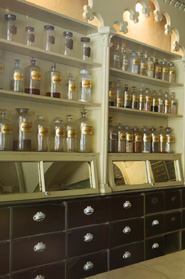
Bottles and drawers.

Vintage pharmacy paraphernalia.
The Stabler-Leadbeater Apothecary Museum in Old Alexandria is located at 105–107 South Fairfax Street, Alexandria, Virginia. The Yellow or Blue Metro Line will take you from DC into Virginia and south along the Potomac to King Street Station in Alexandria. Walk east on King Street, toward the Potomac, and turn right onto Fairfax Street after about one mile. The museum will be on your right. To avoid the walk, take the Dash bus that runs from the Metro station along King Street and stops at Fairfax Street.
Washington, DC is known as L’Enfant’s planned city, and the results of that original vision exude grandeur and opulence. The city did not, however, come into being fully formed. For many years after the construction of major buildings, such as the White House and the Capitol, they stood isolated, surrounded by swampy and insect-infested lands. Filling out the city did not occur smoothly, and the landscape moved indirectly toward the modern city. Much low-cost housing in the form of alleyways interspersed between the main streets was built to house the incoming flow of new residents. Commercial enterprises sprang up to support the needs of the population. Much of this construction has come and gone in the ongoing gentrification of the city. However, remnants of this indirect path can be found throughout the city, from the remaining alleys to antique commercial signage to the lingering stables that housed the horses of days past. Keep your eyes open for evidence of the path of development, particularly in those areas north and south of the Capitol building that have avoided complete modernization.
Tucked between 9th and 10th Streets and N and O Streets lie Naylor Court and Blagden Alley. The cobbled alleyway is lined with polished and unpolished architectural gems, this building among them. To capture this view, stand at the very entrance of the passageway at O Street, which is far enough away so that you will not have to look up at the building and get converging lines in your photograph. I was lucky to be shooting on a blustery spring day with its accompanying blue sky and fast-moving clouds, which makes for a dramatic backdrop. There are often cars parked in front of the garages, which can mar the scene—with the crop that I chose, I was able to keep the vehicles out of this image.
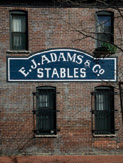
A sign on Blagden Alley.
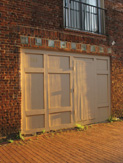
Decorative brickwork in the alley.
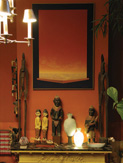
African art at the DC Guesthouse.
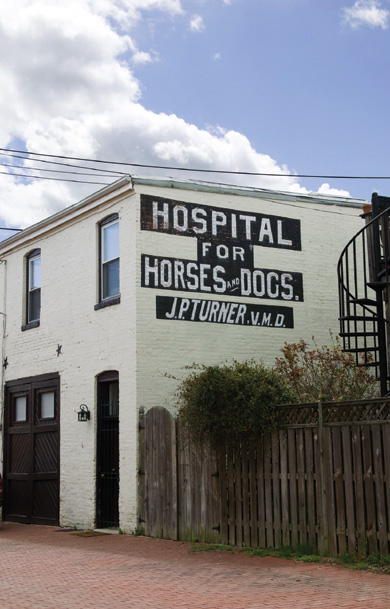
Focal length 53mm; ISO 100; aperture f/8; shutter speed 1/125; April 12:57 p.m.

Beautiful copper work at the entrance of Blagden Alley.
You will find this vintage Coca-Cola sign emblazoned on the side of a building in the South Capitol Hill area. Be on the lookout—it is on a brick wall on S. Capitol Street SW between D Street SW and Ivy Street, amid highway crossovers and railroad tracks. You must use a wide angle lens, because the alley in front of the wall is narrow, and you can barely stand far enough away from the wall to capture all the words. Either use your tripod and spirit level or be very steady while hand-holding the camera, to be sure to render the sign perfectly horizontal. An overcast or cloudy day is the optimal condition for shooting this sign, because the shadows from the brick and mortar are kept to a minimum and do not distract from the painted words.
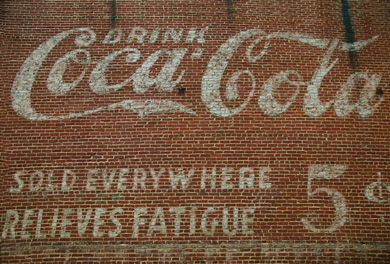
Focal length 28mm; ISO 100; aperture f/5.6; shutter speed 1/320; May 2:19 p.m.
Naylor Court, a surviving example of the Washington alleys, is a network of lanes bounded by 9th and 10th Streets to the north of N Street. From the Mt. Vernon Square Metro Station (Green and Yellow Lines), turn north on 7th Street and walk along the face of the Washington Convention Center to N Street. Turn left on N Street and then right on 9th Street. Naylor Court will be on your left after about 50 yards.
Moving south from the Capitol area, you will shortly enter a region of DC undergoing much change. Bounded to the west by the Potomac and to the southeast by the Anacostia River, this southern part of central DC has for many years taken its tone from the Washington Navy Yard located on the north bank of the Anacostia. Its gritty, urban environment has for some decades featured commerce and light industry in a rather uninspiring setting. However, not for much longer.
The Capitol Riverfront, as it has been recently renamed, is the site of more than $3 billion of investment. Previously known as the Near Southeast, the 500-acre area has benefited from the 2003 Anacostia Waterfront Initiative, which targeted an increase in access to the mile and a half of riverfront and commercial development of the area incorporating environmentally sound initiatives. This has led in short order to a striking rebirth of the area and the construction of multiple new office and apartment buildings. Some government departments, most notably the Department of Transportation, have moved south into new accommodations in the area. In addition, and dominating the skyline, the new Washington Nationals baseball stadium stands looking out across the Anacostia as a testament to the new life of the area. No doubt the Nationals themselves will be able to reflect that new glory as time progresses.
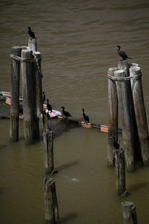
Cormorants on the Anacostia River.
A visit to the Capitol Riverfront presents the opportunity to witness the transformation of a section of central DC and the expansion of the modern city to the water’s edge.
This picture is a testament to the fact that sometimes being locked out can be to your advantage! We were exploring the Riverfront by bicycle (the best way to do so—for all of DC, for that matter), and we landed at the Nationals Stadium far too early for any of the gates to be open. After repeated attempts to find one that had possibly been forgotten, I resigned myself to shooting from outside the fence. Lo and behold, when you are handed lemons…make lemonade! I stood with my camera about two feet from the wrought-iron fence and made a composition that included the “W” of the Nationals’ logo in the foreground. I used a wide aperture in order to make this foreground graphic out of focus. This was an aesthetic decision, of course, but I think the black wrought iron acts as more of a framing element when it is soft and focuses one’s attention on the background information. I centered the red flag between the bars and waited for the wind to gust. The inclusion of the Stars and Stripes to the right was a lucky accident.
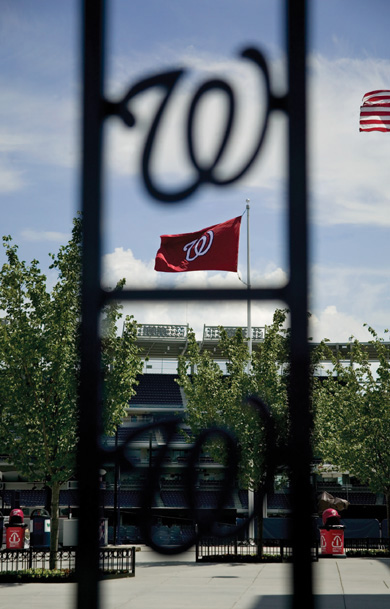
Focal length 85mm; ISO 100; aperture f/5.6; shutter speed 1/1250; May 2:04 p.m.
This photograph is my ode to Charles Sheeler. For those of you who are unaware of Sheeler, he was an American painter and photographer of the early twentieth century who focused on machinery and structures. He called himself a “Precisionist”—one who emphasizes linear precision in his work. In this photograph, the bright, midday sunlight does just that—accentuates the textures and linear details of the industrial buildings. My vantage point for this shot was the apex of the Frederick Douglass Bridge, the southern extension of South Capitol Street that crosses the Anacostia River. I was particularly taken by the quality of the sky and clouds that day, as well as the sharpness to the light. The scene was unusual for a modern cityscape in that the rooftop horizon line was flat and unbroken by anything, save for the two immense smokestacks. The distinct lack of humanity, an odd characteristic for a thriving city, adds even more of a vintage feel.
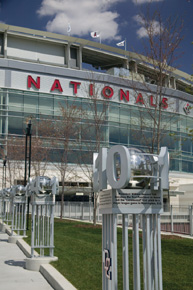
The front of the Nationals Stadium.
The Capitol Riverfront is conveniently located close to the Navy Yard Metro (Green Line) and within walking distance of the Capitol South Metro and Eastern Market Metro stations (both on the Blue and Orange Lines).
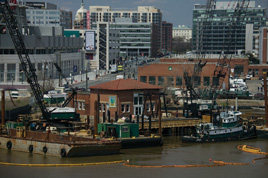
Looking north from the Frederick Douglass Bridge.
Walk west from the Navy Yard Station (400 yards) and then turn south on South Capitol Street, passing the Nationals Stadium, and climb the bridge across the Anacostia River. From the pedestrian walkway, you can obtain fine views of the stadium, the developing waterfront, and the Navy Yards, as well as the human and animal life active on and around the river.
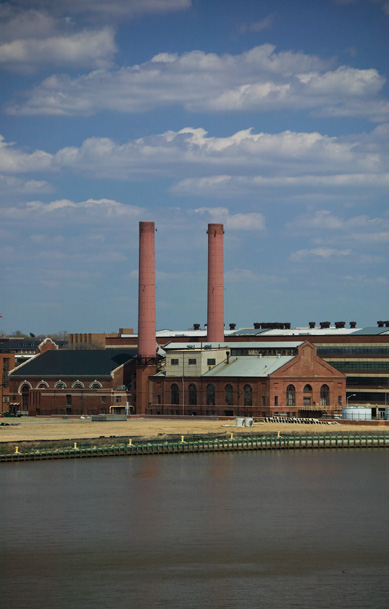
Focal length 150mm; ISO 100; aperture f/5.6; shutter speed 1/800; April 1:01 p.m.
Doorways throughout DC present a glimpse of the individuality of buildings and of their owners. They are the made-up face of the personality of the structure and give us a public glimpse of how the inhabitants want to be known. In particular, the classic Georgian row home with its orthogonal structure often relies on its doorway to make its personality statement. The official structures of Washington employ their doorways to communicate and impress. Every doorway provides a signature of the occupants and thus provides a succinct opportunity to capture an impression of what lies in front of and behind that door. Throughout DC you will pass entryways that are artworks unto themselves, ready to be photographed and documented.
A short video of this scene would have been my media recording method of choice, but, after all, this is a photography book, not a primer on the moving image! I make this comment because of the enormous and motile shadow of the flag that played vigorously across the façade of the building, the Embassy of Turkmenistan at 2207 Massachusetts Avenue NW. What made the image most arresting was the size of the shadow, how exuberantly the flag flapped, and the fact that the source of the shadow was out of view. I could not help but feel that there was a hand outside the frame waving the flag. Silly, I know, but true. My trusty polarizing filter again helped to saturate the harsh and dry light of the midday sun and keep the foliage green and without reflection. My vantage point was from the sidewalk across the avenue, and I was very careful to center the door evenly between the pillars, yet keep the entranceway to the left of my composition.
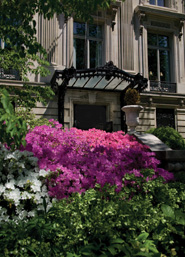
The front of the Cosmos Club.
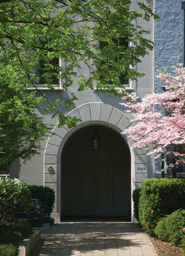
The façade of 2328 Mass Ave NW.
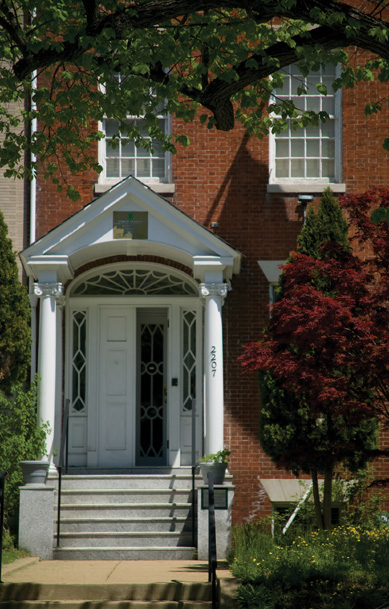
Focal length 130mm; ISO 100; aperture f/5.6; shutter speed 1/320; April 11:35 a.m.
The simple theatricality of its façade makes this building an eye-catcher, especially given its location on R Street, which is lined with dignified townhomes and manorial structures. The architectural firm of Hornblower and Marshall (who also designed the National Museum of Natural History) erected this building, which was originally an art studio, for Edward Lind Morse, a landscape painter and youngest son of Samuel Morse, inventor of the telegraph. The heavy oak door, extraordinary hinges, and sturdy windows all earmark this as a building constructed in the Arts and Crafts style of the early twentieth century. I shot this façade with my 24mm PC (perspective control) lens because the narrow sidewalk and vehicle-lined street make it impossible to stand far enough away to avoid converging lines. Set the lens to its zero position and shift the front element upwards until you see the front of the building where you want it in your frame.
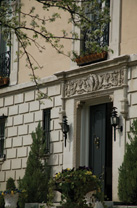
The Cyprus Embassy Residence.
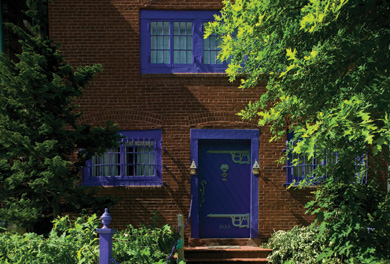
Focal length 24mm; ISO 100; aperture f/7.1; shutter speed 1/80; June 3:28 p.m.
Still round the corner there may waitA new road or a secret gate,And though I oft have passed them by,A day will come at last when IShall take the hidden paths that runWest of the Moon, East of the Sun. | ||
| --J.R.R. Tolkien, Lord of the Rings | ||
Around many turns in the District, you will find finely designed gates that shield the spaces that DC residents have constructed as their own private places. While hinting at the havens that lie beyond, they present elegant visual opportunities that stand in their own right.
Taking photographs of gates and doors can result in very lyrical and poetic pictures. The images are pregnant with mystery and unexplained events. Who lives there? Who just walked through? Is it locked? Is someone leaving? Can I come in? A key to shooting this type of photo is to add, with your image-maker’s bag of tricks, some romance and intrigue. My favorite “add romance here” technique is to shoot with a very wide aperture, which renders the background lush and soft, especially if the scene is bathed in diffused and dappled light. The human eye sees like this—we cannot focus on two planes at once— which is one reason why pictures shot in this style seem so intimate. The photograph becomes much more experiential, and the viewer may feel the scene firsthand, as if he were really there and not looking at a two-dimensional rendition.
This lovely wrought-iron gate is in Old Town Alexandria, on North Fairfax Street between Princess and Queen Streets. The harsh midday sun is mellowed by the thick cover of leafy trees, and the light takes on a chiaroscuro effect, with a fine play of light and shadow dancing on the black metal of the gate.
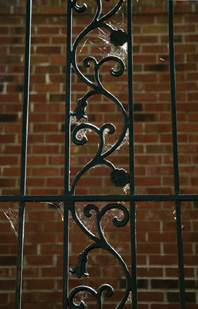
Feather duster needed in Old Town Alexandria.
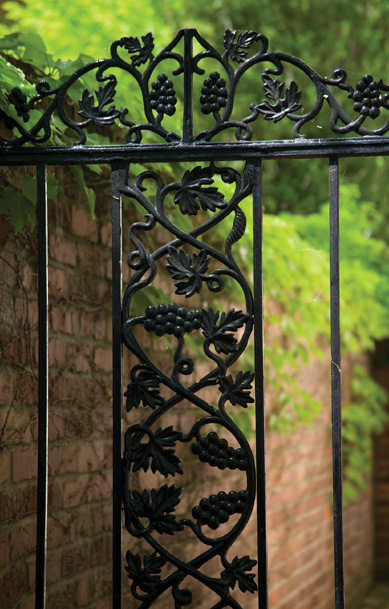
Focal length 105mm; ISO 100; aperture f/5.6; shutter speed 1/25; April 11:03 a.m.
Surrounding the perimeter of the photograph with greenery creates the effect here of a peephole, which, combined with the soft focus of the background and the interesting shadows on the door in the foreground, works to convey a sense of hidden activity happening out of the edge of the frame. The composition is grounded and solid and follows the adage of dividing the frame into thirds—the upper third is almost a picture unto itself, whereas the bottom two-thirds of the photograph play, literally, a supporting role, with beautiful light, texture, and color. I included the band of brickwork on the right side of the photo to tie the two pieces of the image together as one. This photograph is a perfect example of how simple but exquisite elements composed in a classic manner can make an alluring photograph. This gate is a side entrance to the Carlyle House Historic Park and can be found on the corner of North Lee and Cameron Streets in Old Town Alexandria.
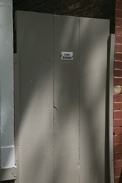
A warning on a gate in Georgetown.
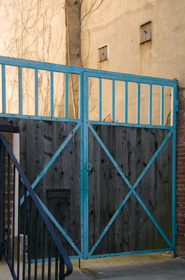
A beautiful mix of color and texture.
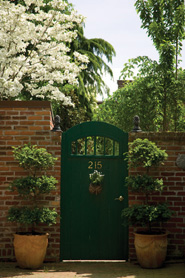
Classic Colonial gateway.
The residential districts in the northwest suburbs with their gardens and side alleys present the greatest selection of gates, but unique and imaginative examples can be found throughout the District and Old Town Alexandria.
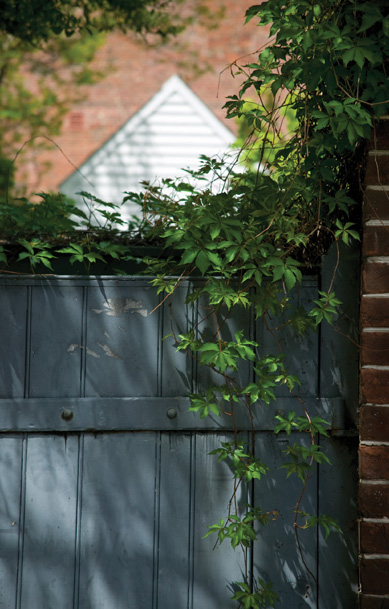
Focal length 117mm; ISO 100; aperture f/5.6; shutter speed 1/100; April 11:14 a.m.
Start with the Chautauqua Assembly, an organization that flourished in the late nineteenth and early twentieth centuries, dedicated to the dissemination of culture to, and the entertainment of, the whole community. In 1891, locate a unit of the Assembly in Glen Echo Park to the far northwest of the city, over the state line into Maryland. In the early 1900s, convert that site of culture into an amusement park that will thrive until the 1960s and then convert the park back to a center dedicated to the practice and teaching of the arts. Overlay onto that custodians dedicated to the preservation and enhancement of the site, and what have you got? A truly unique place that has been meticulously preserved, which provides you with opportunities to capture almost surreal shots of amusements from times past and the art deco structures that surround them.
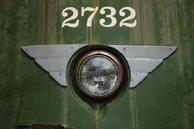
The front view of the Glen Echo trolley car.
Glen Echo is a wild and crazy place with heavy artistic overtones. You will feel completely at home carrying your camera and peering through the viewfinder, because the park (it is run by the National Park Service) administers a very active artist-inresidency program, and photographers, among other artistic types, abound.
The Dentzel Carousel alone will keep you occupied for hours, with its 38 horses, 2 chariots, 4 rabbits, 4 ostriches, a lion, a tiger, a giraffe, and a prancing deer. It is a veritable sensory overload. You can choose to shoot the carousel while it is spinning and try to capture part of its frenetic personality, or you can do what I did and take moody portraits of the animals. Even in the full light of day, the carousel pavilion is dim, with the dark-green roof obscuring most of the natural light. Use your tripod (which is usually not allowed on NPS property, but the rangers have a soft spot for artistic types) and try to include some of the many incandescent bulbs. They add a nice, warm glow and highlight the decorative gold-leaf details.
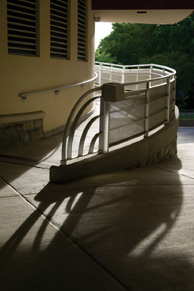
Art Deco shadow play.
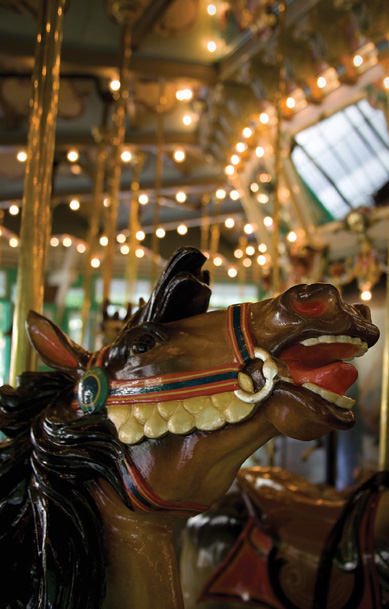
Focal length 41mm; ISO 100; aperture f/4.5; shutter speed 1/15; May 5:14 p.m.

Focal length 60mm; ISO 100; aperture f/7.1; shutter speed 1/200; May 10:33 a.m.
The entrance to the Crystal Pool has been beautifully restored to all its Art Deco glory and makes a perfect clean and geometric subject for picture taking. The grass berms immediately surrounding the doorway are scattered and uneven, and in order to avoid converging lines, you have to be very mindful that you and your camera are level with the architecture. I am small, and I actually stood on top of one of the hillocks to center my camera on the entrance. The day was bright and slightly overcast, which served me well here, because stark and contrasty shadows would have been very distracting. Rather than be off put by the asymmetric stone wall at the front, I used it to my advantage. The red metal railing became a strong foreground element, and the diagonal line created by both the railing and the wall pointing toward the viewer adds depth to what would otherwise be a very flat and somewhat dull picture.

The now defunct Cuddle Up amusement park ride.
Glen Echo Park is located at 7300 MacArthur Boulevard in Glen Echo, Maryland. It is best approached by car. From the Capital Beltway (Interstate 495), take Exit 40 on the outer loop or Exit 41 East on the inner loop. Take Clara Barton/Cabin John Parkway to the MacArthur Boulevard/Glen Echo exit. Make a left onto MacArthur Boulevard. Cross Goldsboro Road and then make a left onto Oxford Road, where you will see the parking lot. From the parking lot, follow the path across the Minnehaha Creek bridge and enter the park.
From downtown Washington, take Massachusetts Avenue to its northwest end at Goldsboro Road. Turn left and continue to MacArthur Boulevard. Turn right on MacArthur Boulevard and take an immediate left onto Oxford Road, where you will see the parking lot.
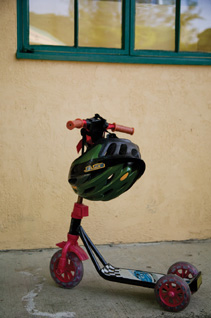
A scene near the Glen Echo playground.
Washington holds a special place in the hearts of many Americans. Having lived a life of service to their country, military personnel find here an ideal last resting place, a chance to come home to the center of the country that was at the center of their lives. And here lives are commemorated with emblems of both country and religion. Not ostentatiously, but with discretion and taste, hidden in plain sight and waiting for you to search them out.
The extended rows of small white tomb markers are the images that many recall of the gravestones at Arlington Cemetery. There is, however, in Section One, at the very top and far end of the cemetery, an impressive selection of ornate and elaborate grave markers that generate beautiful photographs. Among these markers—and interspersed throughout the city, for that matter—perch eagles, resplendent in their role as patriotic emblems, standing watch on behalf of those who gave so much.
In America, the appearance of gravestones and their status as craft and art form has undergone quite a transformation. What began as stones and boulders that were placed on top of the grave to, superstitiously, keep the dead from rising out of their tombs became sculptures rife with images of horror in the form of skulls, skeletons, and death angels. It was not until the Victorian era that the motifs changed from those of eternal damnation to images of everlasting peace and ornamental descriptions of the person who lay beneath. The image of the angel was used to show her role as messenger between heaven and earth, with the trumpet the instrument of choice. Here we have the winged and draped figure heralding the demise of a good captain. The late-afternoon sun brought out beautifully the cast texture of the wings and clothing, displaying also the marked contrast in the cyan tone of the sculpture and the drab gray-brown surface of the stone. The bare trees make a background that works both visually as a pattern against the sky and conceptually as a metaphor for lifelessness.
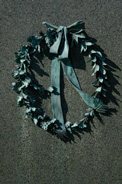
A lifelike decoration on a gravestone.
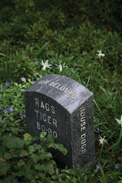
Flowers embellish this gravestone of the Post family’s dogs.
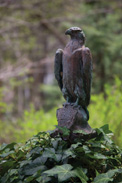
A watchful eagle perched amongst English ivy.
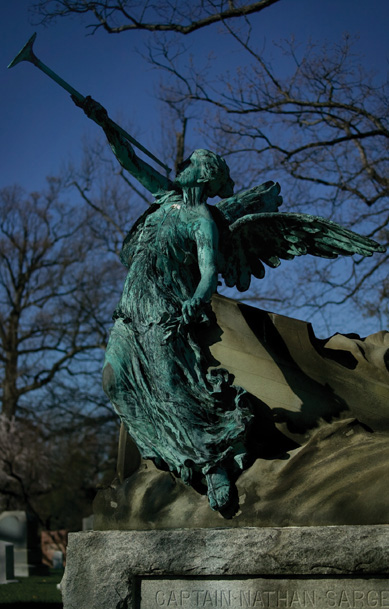
Focal length 70mm; ISO 100; aperture f/5; shutter speed 1/2500; April 3:53 p.m.
This eagle sits atop, with his symmetric partner across the drive, a granite plinth and arch that flank the entrance to Arlington National Cemetery. From afar, they make quite a visible and dignified pair, but if you are on foot when visiting the area, they can easily be missed because of their height. At a point in history, there was not complete agreement on the choice of an eagle to represent the new nation of the United States. Benjamin Franklin felt the eagle was dishonest and lazy, because it made common practice of stealing fresh catch from the beaks of the fishing hawk. Mr. Franklin’s choice for the nation’s ornithic symbol was the turkey! Stone carvers would have to be quite talented to bring to a turkey the same majesty and poise that the eagle conveys….
To capture this image, stand on the cemetery side of the arch, facing northeast. The afternoon light coming from behind you highlights the carving of the feathers and musculature, and your low vantage point heroicizes the figure.
Arlington National Cemetery is located a short distance into Arlington on the southwest bank of the Potomac River. It is reached via the Arlington Memorial Bridge, which itself is to the southwest of the Lincoln Memorial and the Mall. The Arlington National Cemetery Metro stop is regularly served by Blue Line trains.

Focal length 150mm; ISO 100; aperture f/5.6; shutter speed 1/2000; April 2:24 p.m.
Until recently, no cabinet-level government department had relocated for more than three decades. In 2007, the U.S. Department of Transportation was, perhaps appropriately, the department to break that streak. Taking advantage of the redevelopment of the Capitol Riverfront area in Southeast DC, the DOT and 7,000 workers moved into an impressive new building located in the heart of the reenergized area.
The structure consists of the East and West Buildings, which sit on an 11-acre plot bounded by M Street, New Jersey Avenue, and 4th Street. The architecture of the buildings combines a modern feel appropriate to the rebirth of the area with a classical framework appropriate for a structure expected to stand for many decades in the ranks of major government buildings. The buildings are bordered by a Walking Museum illustrating the history and importance of transportation to the U.S. Overhead structures represent different bridge types, while a variety of exhibits combine the educational with the artistic, exemplifying the vital role that transportation plays in the national interest.
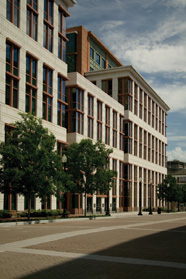
The main buildings at the DOT.

Transportation walk—a display of bridges and sculptures.
Here we have—not really that surprisingly, as it is in a similar neighborhood—another “Charles Sheeler-esque” photograph. What is most reminiscent of his work in this image are the multiple vertical smokestacks and the heavy industrial feel. The plaza surrounding the new DOT buildings is filled with sculptures that reference a vast number of transportation modes, and this one is an ode to cross-country trucking.
I used my 50mm lens to capture the smokestacks and the authentic industrial environment, which was beautifully lit on this clear spring day. The normal lens also maintained the true verticality of the up-and-down elements in the shot—converging lines would have ruined the effect of repetition that this image displays.
Be sure to stand at the edge of the sculpture, pointing your camera down the row of stacks. This way, the sense of perspective is exaggerated, as the vertical elements reduce in size toward the horizon. Be aware of your placement of the brick stacks in the background— inclusion of these is crucial. A saturated blue sky perfectly complements the overall color scheme of browns, grays, and blues.

Focal length 50mm; ISO 100; aperture f/7.1; shutter speed 1/250; April 1:38 p.m.
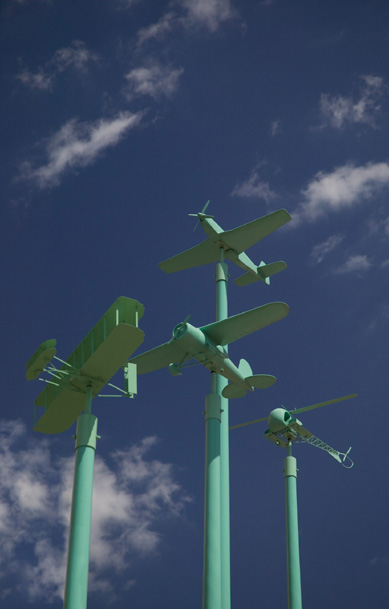
Focal length 100mm; ISO 100; aperture f/7.1; shutter speed 1/250; April 1:28 p.m.
Photographing art and sculptures can be very satisfying, because part of your work is already accomplished for you. In a sense, shooting art is a collaboration between the artist and you. You already have something attractive and worthy in front of your camera, and now it is your responsibility to render it into a photograph in a well-composed and appealing fashion. To that end, what could be a more perfect background for a selection of aeronautical sculptures than a blue sky with wind-tossed clouds? These sculptures are quite tall, and you will invariably have to look up at them. Find a pleasing arrangement where the wings and tails are not overlapping each other in a distracting way. I stood with the sun to my right, which cast shadows that brought out the texture and shapes of the planes. The sidewalk is light colored, as is the building that is immediately to the left of where I was standing—these two surfaces bounced light back into the scene, keeping the contrast ratio low. You can almost hear the drone of the turbine engines as the soundtrack!
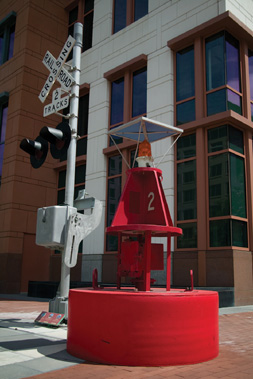
A railroad-themed sculpture.
The entrance to the U.S. Department of Transportation is located at 1200 New Jersey Avenue SE. The department buildings run along the south side of M Street SE and can be readily accessed by taking the Metro to the Navy Yard Station (Green Line). Leave the station via the Navy Yard exit, and the DOT will be across M Street and to your left.
If you drive to the area, you will be able to take advantage of (paid) parking lots on M Street and New Jersey Avenue. From there, you will be able to explore all of the burgeoning Capitol Riverfront area.
The United States is one of the most influential countries in the world. Its national capital therefore finds itself playing a second and highly international role. At an informal level, this can be seen through the many restaurants, residents, and visitors exhibiting foreign cultures on the streets of the city, but at a more formal level, Washington demonstrates its global reach through a multitude of embassies, museums, memorials, gardens, churches, banks, organizations, and universities, each with some form of international flavor and each with a story to tell of other lands. A statue in memoriam to Sir Winston Churchill stands with one foot on British soil and one foot on U.S. soil at the edge of the grounds of the British Embassy. The Islamic Center on Massachusetts Avenue incorporates a mosque and meeting place for Muslim residents and visitors. Japanese cherry trees around the Tidal Basin and the Japanese Garden at the Hillwood Estate speak gently to the ties with that country. Mahatma Gandhi’s statue strides forward with quiet purpose in a small park opposite the Indian Embassy.
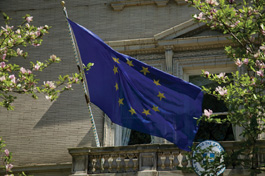
The flag of the European Union.
The shooting conditions here were such that in order to make this photograph actually seem natural, I had to use a few tricks and techniques. Given the time of day, the sunlight, of which the foliage reflected a great amount, was quite harsh and unforgiving, causing the lush spring leaves to look light and dry. Also, the midday sky was rendered light and unappealing. Ta da! Out comes the trusty polarizing filter, an accessory you should never leave home without. With a twist of the wrist, the sky turns an azure blue, and vitality returns to the foliage.
The second problem I had to attend to was the shadow on the front of the statue from the overhead light source. My on-camera flash, set at two stops under the ambient light, brought just enough fill light into the scene to show the detail of the front side of the statue without looking artificial.
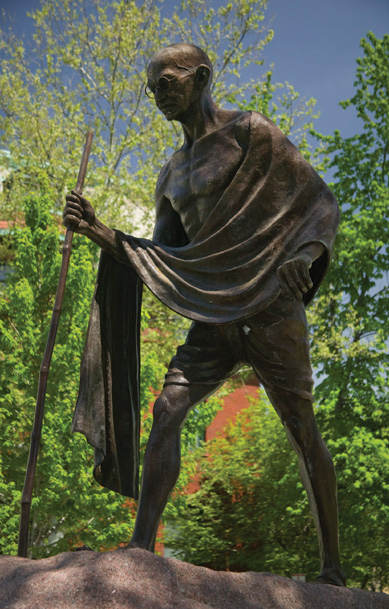
Focal length 65mm; ISO 100; aperture f/5; shutter speed 1/160; April 11:51 a.m.
The quality of light in this photograph demonstrates the beauty and good fortune of a lightly overcast day. I was shooting at very close to noon, albeit two weeks earlier than the previous situation, but you can see how much less contrasty and more open the shadows are, even though the direction and hour are almost identical. For this reason and the fact that colors stay intense and saturated, the light of a slightly overcast day can be some of the nicest in which to photograph. Gardens, foliage, and organic surfaces benefit greatly from the slightly softened contrast, but you will also find this a preferred lighting situation for portraits and architectural shots. This Japanese garden at Hillwood is on a steep bank, and as you descend the stairs, look behind you, and you will see this tableau. The uphill view greatly enhances the composition—the horizon line is raised without having to tilt the camera, and your canvas is literally filled from edge to edge with subject matter.
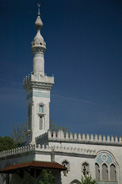
The minaret of the Islamic Center.
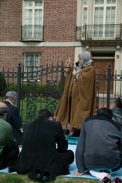
Muslims praying streetside.
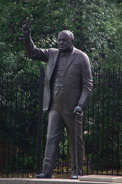
A statue of Churchill and his diplomatic stance.
The Mahatma Gandhi Memorial is located on a triangular island along Massachusetts Avenue where it intersects with Q Street and directly across the road from the Embassy of India at 2106 Massachusetts Avenue NW.
The Islamic Center is found at 2551 Massachusetts Avenue NW.
Sir Winston Churchill’s statue is sited in front of the Ambassador’s residence at the British Embassy at 3100 Massachusetts Avenue NW.
The Embassy area can be accessed from the Metro station at Dupont Circle (Red Line), followed by a walk or bus ride northwest along Massachusetts Avenue.
Hillwood Estate, Museum, & Gardens is located on Linnean Avenue NW. See the Hillwood Estate section in Chapter 4 of this book for directions.
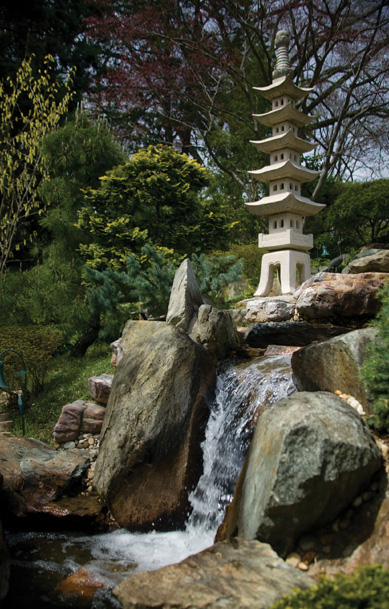
Focal length 33mm; ISO 100; aperture f/3.5; shutter speed 1/250; April 12:48 p.m.
The charm of Old Town Alexandria rests on the retention of its historical culture and architecture. The city, 50 years older than Washington, was formally laid out in 1749. Brick sidewalks and cobblestone streets are reminiscent of those times, as are the restored seventeenth- and eighteenth-century residences and businesses. The many passageways and nooks and crannies between the buildings, originally constructed to suit foot and horse traffic, present perhaps the most charming of features and photo opportunities.
Passageways, tunnels, alleys, backstreets, paths—pictures with these design elements can tell stories and elicit questions, much like the doorways mentioned earlier in this chapter. The archway or opening of the passage can be thought of as a lacuna—a gap or a peephole—which is often accompanied by greenery, branches, or some other type of semitransparent barrier that adds another layer of interest and mystery to the photograph.

Looking down an alleyway off South Fairfax.
I was fortunate enough to walk past this opening in the brick wall at the very moment that the women were embracing. If I had arrived a couple of seconds before or afterward, I would never have seen this intimate encounter. I like the fact that the image has many layers as your eye travels toward the centered subject—the sidewalk outside the archway, the greenery in the planters, the actual step through the arch, the brick path, the shrubbery slightly covering them, and then the women themselves. These layers make for a much more interesting image than would a straight photograph of the women hugging as they greet each other under this arch on Prince Street.
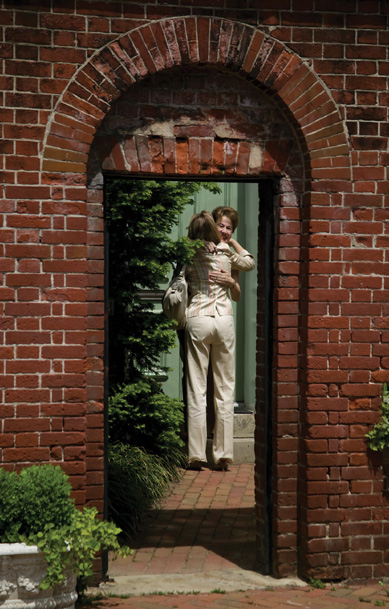
Focal length 135mm; ISO 100; aperture f/5.6; shutter speed 1/400; April 12:10 p.m.
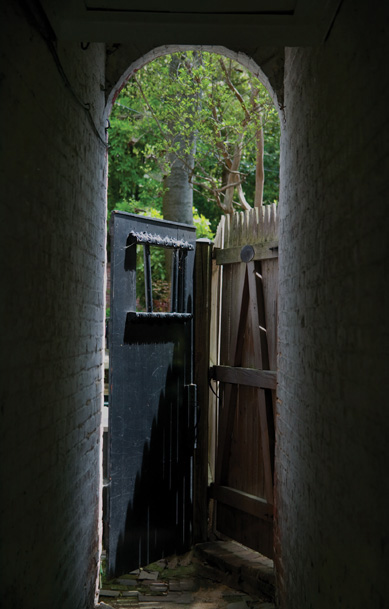
Focal length 75mm; ISO 100; aperture f/5; shutter speed 1/25; April 12:05 p.m.
Here again we have an image that has many layers, visual metaphors, and paths down which the eye can follow. A narrow brick alleyway leads through an archway to an odd image of two doors set at an acute angle to each other. Through the framed window of one of these doors, we can see the leafy branches of trees that also veil what is beyond, further into the copse. There is history, and thus allegories and tales to be chronicled, evidenced by the moss on the cobblestones, old bricks in the wall, and quirky construction of the two gates. Keep your mind and eyes open to cinematic images such as this. Let your thoughts and vision wander. If I had not been mindful as I strolled down South Royal Street (walking north toward Prince Street), I could easily have missed this little glimpse. Explore and be adventurous—your photographs will be all the better for it.
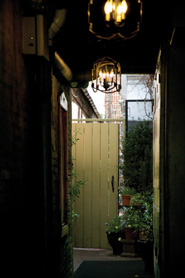
A peek behind a restaurant on Pitt Street.
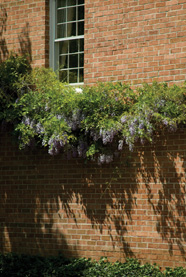
Wisteria growing on an alley wall near Oronoco and N. Lee Streets.
The Yellow or Blue Metro Line will take you from DC into Virginia and south along the Potomac to King Street Station in Alexandria. The station is located to the west end of Old Town. Walking east on King Street will take you through the town, reaching the waterfront after about one mile. To avoid the walk, take the Red or Yellow Dash bus lines that run from the Metro station along King Street to the waterfront. Old Town lies in the blocks to the north and south of King Street.
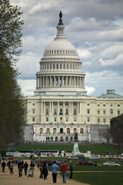
Washington, DC has a lot to offer!

